|
|
Welcome to the Summer issue of the LIFE Dee River newsletter!
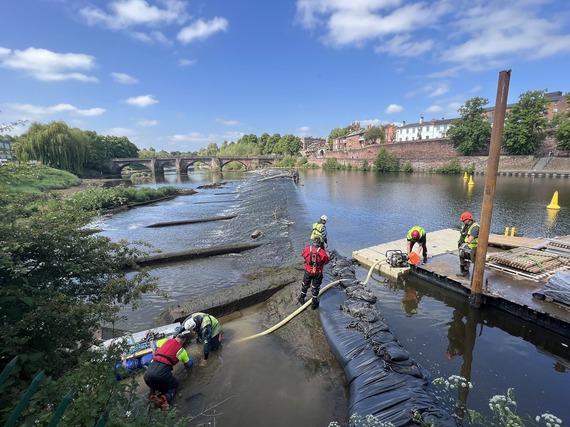
Only days after our improvement works were completed to help downstream migration at Chester weir, juvenile fish were seen passing through the notch! Watch the video here.
In partnership with the Environment Agency, the aim of the work was to improve downstream passage for young salmon and sea trout. Located at the tidal limit of the Dee, Chester weir is 150 metres in length and 3 metres high. An existing canoe and fish gate was in place in the weir crest that had not functioned for over 20 years. Prior to the work, young fish were often delayed on their downstream journey by the weir, particularly at low flows in the spring when there was not enough water to help them pass over the structure. Unable to swim over such a large man-made barrier, fish would congregate above the weir and were more vulnerable to predation from birds and larger fish.
Work to dismantle the existing gate and surrounding structure was carried out during low tides by experienced local contractors, using a pontoon to transport materials across the river. A new, specially fabricated stainless-steel gate was installed which is operated by a winch on the bank, allowing it to be opened and closed easily at key periods throughout the year. This important work will provide a safe route downstream for juvenile fish, reducing delays at the weir and increasing their chance of survival. Read the full press release here.
|
|
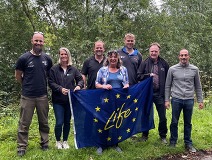
During the last week of July, we had our second monitoring visit, welcoming colleagues from the EU’s LIFE programme; Gustavo Becerra-Jurado, LIFE programme Project Manager based in Brussels, and Dr Lynne Barratt working for ELMEN EEIG, responsible for the technical and financial monitoring of LIFE projects.
Firstly, they visited the hatchery at Clywedog, as the Dee freshwater pearl mussels have successfully reproduced for the first time, this is great news for the captive rearing programme of this critically-endangered species. Recently, improvement works to the infrastructure of the hatchery was funded by the 4 Rivers for LIFE project.
Moving north to the Dee catchment, we took Gustavo and Lynne to see some of the weirs that we’ll be adapting in the coming years, such as Horseshoe Falls, Manley Hall and Erbistock. We highlighted the multiple benefits of delivering this work for both upstream and downstream fish migration, along with the varied challenges that we face at these sites.
Delivering on cross-border projects with different governing bodies, and working on sites in protected areas would only be possible through collaborative working. We want to thank our project partners, Carrie Wright from the Environment Agency and Dafydd Roberts from Eryri National Park Authority for attending the mission visit and showing their continued support of the project.
|
|
|
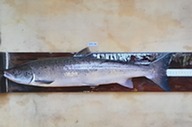
As well as observing the movements of anadromous sea and river lamprey, we continue to tag salmon for acoustic telemetry monitoring. For all species, this gives an indication of how our fish respond to environmental variables, such as flow and temperature changes. And, by placing acoustic receivers in the vicinity of potential barriers, this allows us to assess the impact in-river structures have on fish migration; be that a complete barrier or causing significant time delays. In the last month, we completed the tagging of twenty adult salmon to add to this dataset. So far in 2023, from lamprey and salmon, we have received over 200,000 detections!
A good example of how we use this data is the newly completed gate on the notch at Chester weir. We have witnessed that under low flows, salmon smolts can be delayed at this weir for several days which leaves them vulnerable to predation. The addition of the new gate enabling passage through the notch at key periods should significantly reduce delays, improving survival chances.
|
|
|
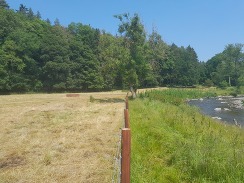
In 2021, just east of Chirk on the River Ceiriog, the project fenced some sections of river that had suffered from cattle erosion, as well as damage from some very high winter river levels, and we are now beginning to see the fruits of our labour. Some sections were further strengthened using natural revetment techniques of coppiced timbers, some of which are now sprouting shoots and starting to grow as riverine trees. Further bank stabilisation was achieved by planting a variety of locally occurring trees – alder, hawthorn, willow, oak and rowan – which in time will provide river shade.
Since the exclusion of cattle, a dense grass and shrub layer has established providing a better habitat for wildlife (see photo, taken earlier this summer). Of note are the tall growing teasel, visited by pollinating insects when in flower and birds, especially goldfinch when seeding. We will look out in autumn for goldfinch settling on the old, brown flower heads to 'tease' the seeds from them. As ever, we are grateful for the cooperation and support from landowners and farmers, as well as the local contractors, in carrying out this vital work.
|
|
|
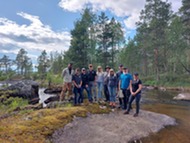
In July, the team headed out to Jämtland, Sweden to visit four different LIFE projects, as part of our project’s actions to disseminate learning and share best practice with other LIFE projects in Europe. It was a fascinating and busy few days in the Gimån catchment area as we visited Rivers of LIFE; EcoStreams for LIFE; LIFE Triple Lakes; and Grip on LIFE. These were all freshwater projects, but Rivers of LIFE was the most comparable project to ours in terms of scale, target species and actions to be delivered. Like us, their aim is to restore their rivers to a more natural state, removing barriers to migration, creating good habitat, and improving numbers of fish and freshwater pearl mussels. We were delighted to witness their vast populations of freshwater pearl mussels, with over a million mussels including a few juveniles too – see underwater photos we took here.
It was a fantastic opportunity for us all to share our experiences and knowledge of river restoration, and learn about the different challenges we face but, reassuringly, using similar methods to reach our end goals. Whilst many of our project’s issues relate to pollution, man-made barriers, and poor agricultural practices, their main challenge in Sweden is dealing with the aftermath of the timber floating era. During the industrial revolution, the timber industry increased dramatically, and the water courses were used to transport timber from the depths of the forest to industries along the coast. To efficiently float the timber, the water courses were cleared of boulders and straightened, leading to channelised and uniform rivers with smooth riverbeds and walled-in ‘riparian’ zones. This destroyed most of the river’s habitat, and had a drastic impact on freshwater species. The team have been working hard to address these issues, and their hope is to re-create a diverse aquatic environment, strengthen the natural flora and fauna, and create a thriving ecosystem once again.
We can’t thank them enough for being so generous with their time, showing us such a wide range of sites across a vast area, and being so friendly and hospitable. We look forward to welcoming them here next year to visit the LIFE Dee River project.
|
|
|
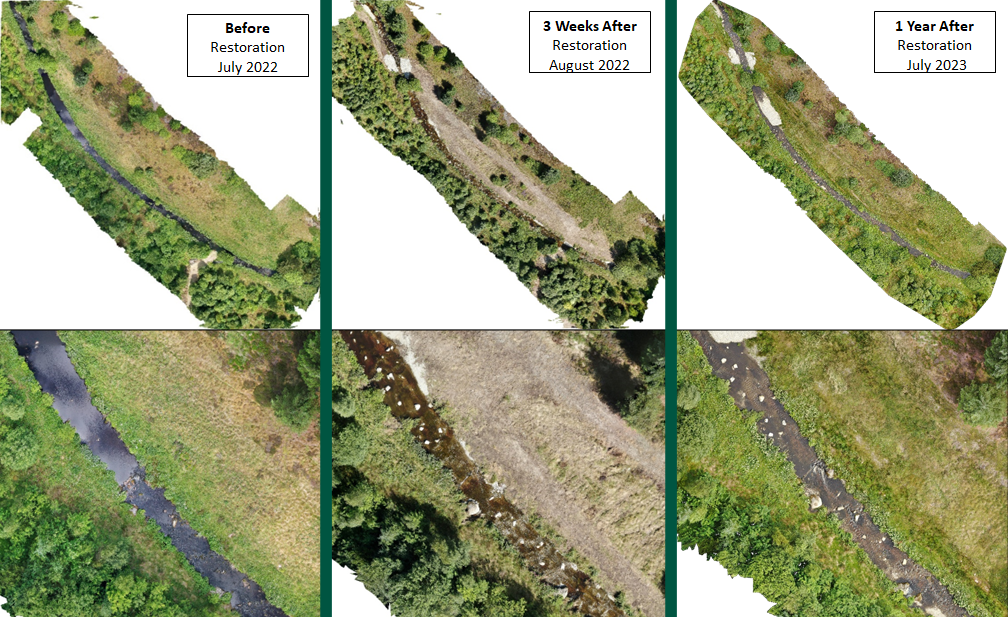 Afon Alwen - Before, After and Now
The use of, and capability of drones, has advanced considerably even during the short lifespan of the LIFE Dee River project. We have three trained drone pilots in the team who use our drone to record physical changes that the project is making - taking aerial photographs pre, during and post restoration work. This is very useful in monitoring and recording change, but is also a visually impactful way of demonstrating the scale and detail of our work during presentations, press releases and on social media. The use of aerial imagery also helps our restoration officers to evaluate the impact of their interventions from above - this offers significant advantages over viewing their sites at only ground level. Using the information captured by the drone, our officers may decide that intervention sites would benefit from more boulders, gravel or bankside work based on this improved elevated view or to perhaps add extra materials when planning future works.
One particularly useful tool deployed on the project is ortho-rectified (OR) photography to record changes over more significant time periods - say years! By flying over an intervention site and taking highly detailed images mapped at regular intervals, these photographs can then be stitched together to make one complete photo, without losing the important finer detail. Sites usually require between one hundred and four hundred individual photos to create one final OR image and can span over 500 metres in length.
Photos: The Afon Alwen prior to, immediately after, and one year post river restoration work.
|
|
|
Alwen Culvert Designs
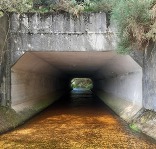
We have been working towards a fish passage solution for the B4501 road culvert on the Afon Alwen. Working closely with our designers, JBA Consulting, and Conwy County Borough Council, we have considered several design options and now have a solution which will provide fish passage, and also allow for future maintenance inspections. This is a completely bespoke design for this location.
Providing fish passage here will allow access to 1km of prime habitat. Recent electrofishing surveys showed how important this project will be, as salmon fry were recorded below the culvert but none were found above the culvert, suggesting it is a barrier to migration.
|
Bala Boulders
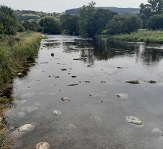
In early September, we are planning to deliver a large boulder introduction project in the upper main river below Bala. This project will introduce 500 tonnes of boulders into the river as well as moving existing stone to create fry habitat and refuge areas for larger fish.
In the 1950s this area was straightened and dredged, and this work will go some way to restore this section of river. We are grateful to Rhiwlas Estate, and Bala & District Angling Association for their cooperation with this project.
|
Weir Z
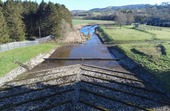
Work will start soon on Weir Z which is part of the Bala sluice system. Weir Z is located on the Afon Tryweryn and operates as a relief channel under high flows. It is proposed we remove a section of this weir down to bed level to allow free passage for all fish species which use the channel in high flow conditions.
|
Keep up to date with our progress…
Visit our webpage for all the latest news about the project, or follow @LIFEAfonDyfrdwy on our Facebook, Instagram, and Twitter feeds to find out what we’ve been up to recently.
Website: naturalresources.wales/LIFEDeeRiver
Email: lifedeeriver@cyfoethnaturiolcymru.gov.uk
|
|
|
|
|